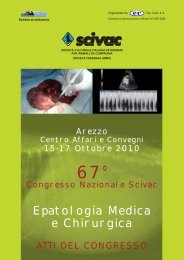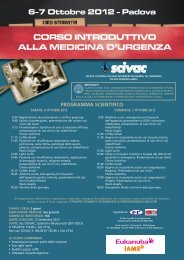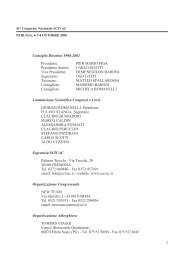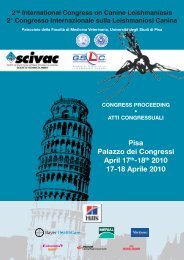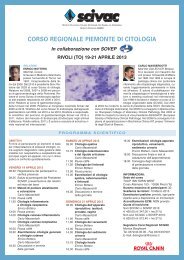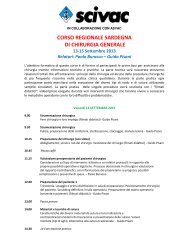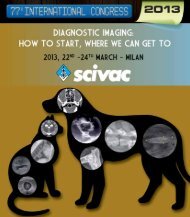58° Congresso Nazionale SCIVAC: Oncologia veterinaria
58° Congresso Nazionale SCIVAC: Oncologia veterinaria
58° Congresso Nazionale SCIVAC: Oncologia veterinaria
Create successful ePaper yourself
Turn your PDF publications into a flip-book with our unique Google optimized e-Paper software.
58° <strong>Congresso</strong> <strong>Nazionale</strong> <strong>SCIVAC</strong> • Milano, 7-9 Marzo 2008 • <strong>Oncologia</strong> <strong>veterinaria</strong> - Alle soglie del III Millennio<br />
Cancer is recognized to be the leading cause of death in dogs and cats over<br />
10 years of age. As <strong>veterinaria</strong>ns become more successful in managing general<br />
health issues in geriatric patients, the incidence of cancer inevitably increases.<br />
Systemic therapy for cancer traditionally requires the use of cytotoxic chemotherapeutic<br />
agents that target rapidly dividing cell populations. Therefore, common<br />
adverse effects seen with chemotherapy use are related to damage to the<br />
cells of the body that have rapid and obligatory patterns of cell replication, such<br />
as bone marrow cells and gastrointestinal epithelium. Drug-specific and speciesspecific<br />
adverse effects are also of significant concern. This lecture will provide<br />
an overview of anticancer drugs commonly used in veterinary medicine. Before<br />
discussing the drugs themselves, it is important to note that anticancer cytotoxic<br />
drugs are potential mutagens and teratogens, adding a significant biohazard<br />
potential for staff administering the compounds, and for clients exposed to<br />
treated animals. Appropriate biohazard guidelines should be followed when anticancer<br />
chemotherapeutic agents are prescribed in veterinary medicine.<br />
ANTICANCER ALKYLATING AGENTS<br />
The alkylating agents are cytotoxic due to their ability to contribute alkyl<br />
groups to biologically important macromolecules such as DNA and proteins.<br />
Alkylating agents are classified as being either monofunctional or bifunctional,<br />
based on the number of reactive sites. The DNA adducts and cross-linkages<br />
caused by alkylation injury prevent DNA replication and ultimately result<br />
in cell death. The effects of alkylating agents are not cell-cycle phase specific.<br />
Mechanisms of cellular resistance to alkylating agents include altered cellular<br />
uptake, increased production of nucleophilic substances such as sulfated<br />
compounds, and increased DNA repair.<br />
CYCLOPHOSPHAMIDE<br />
Cyclophosphamide is the most commonly used alkylating agent worldwide in<br />
human and veterinary oncology. It was synthesized in 1958 and is used most often<br />
as a part of combination chemotherapy protocols for a wide variety of cancers, as<br />
well as being an immunosuppressive agent for treatment of autoimmune diseases.<br />
Mechanism of action<br />
Cyclophosphamide is classified as a bifunctional alkylating agent. The 7-<br />
N position of guanine is the preferred target for attack by this drug. Effects<br />
57



